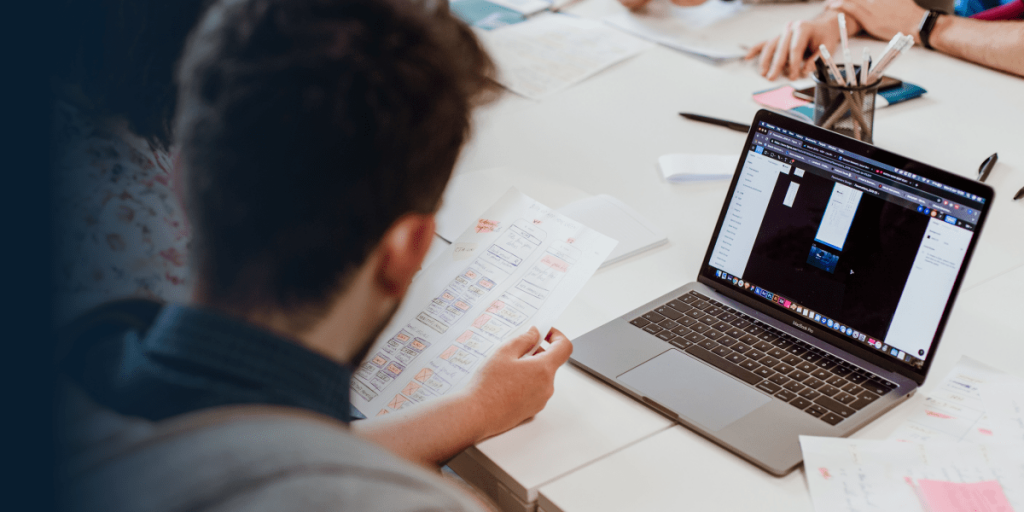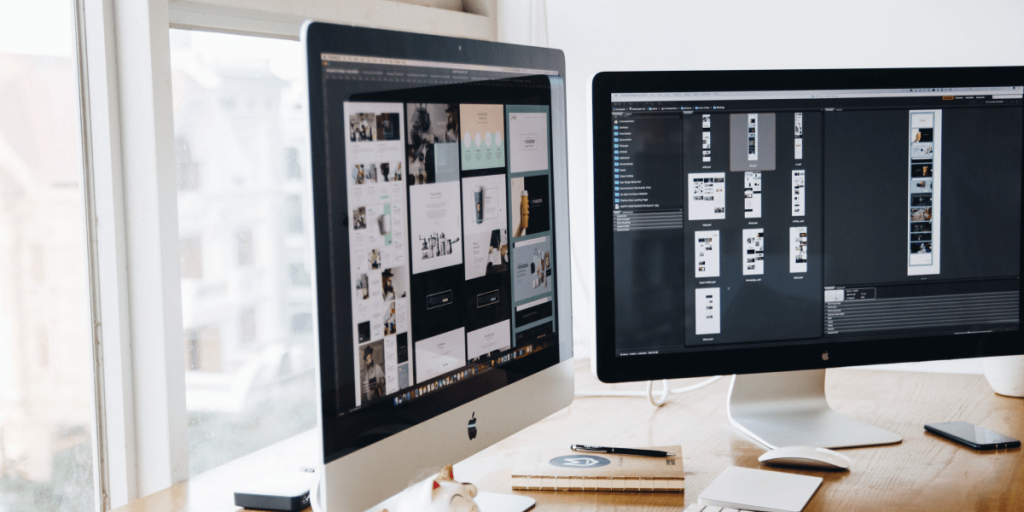Website Redesign Checklist and Tips to Follow
Your website is the prominence of your brand awareness, social media, lead generation, digital marketing and sales strategies. As technology often changes, your website interface design is a continuous process and custom development is needed. There comes a time when every business needs a website redesign.
We truly understand the importance of a top-notch website, therefore, we prepared this article to bring forward the importance of website design, the reasons for the redesign process, proper planning, and redesign checklist. We want to help you turn your website into a powerful tool for long-term success.
What is Website Redesign?
The process of rejuvenating and improving the entire look and feel of an existing website is called website redesign. A redesign project might include converting the current site into a new platform or add new features and functionalities.
A full website redesign is required when switching platforms. An example might be the case where you are converting from HTML to WordPress. If you use WordPress as a content management system and you would only want a new website design, it will be required to redo the entire site. The good news is that you will be able to keep the current content and all the existing functionalities.
How Do You Know Your Website Needs a Redesign?
Redesigning your current website is a plan that demands full commitment in terms of time and money. Some business owners will find excuses not to do it. We are going to enumerate a few solid reasons that might change your mind.
1.Your Website is Outdated
The online world and the set of best practices are changing rapidly. Even if your website was optimized and was user-friendly years ago, that does not mean that it is up to date and respects the best practices now. If you neglected your website for years, you might lose the opportunity to spike up your business based on the current search engine optimization (SEO) updates, Google’s algorithm, user experience(UX) and new technologies.
We strongly recommend a thorough analysis of your website, users behaviour and figure out if your website is meeting your business goals or if it needs a “facelift”.
2.Significant Decrease in Traffic
Not getting the number of visitors as you would like or you notice a decline in the number of website visitors, we suggest considering boosting your online marketing activity and look for new ways to enhance your website’s potential.
A website redesign project can be your opportunity to discover the weaknesses and missed SEO opportunities. You can build a new version that is going to perform better, bring you more organic traffic and rank higher.
3.High Bounce Rate and Low Time on Site
Your efforts on bringing visitors to your website will be useless if your target audience is not spending time on your landing pages or leaving your website immediately. When a website is good, its purpose is to get visitors to spend time on-site, navigate through pages and make them coming back for more content. When your target audience does not act this way, maybe it is time for you to reconsider your marketing strategy and redesign your pages to keep potential customers engaged and to get repeated visits. This might be the right time to rethink your content strategy and make your call to action (CTA) more compelling.
4.Not Mobile-Friendly
One of the most frequent mistakes is not having your website optimized for mobile while knowing that nowadays, 51% of digital media time is accessed via mobile devices. Not thinking about this aspect, will result in traffic loss, high bounce rates, poor conversion rates and low search engine rankings.
A mobile-friendly website must be the most urgent item on your list. If you don’t know what method to choose for a mobile-optimized website, we wrote a useful article about the pros and cons of responsive design vs dynamic serving vs dedicated mobile websites.
5.Changes in Business Strategy
Any change in the overall strategy and goals needs a website update. We recommend it especially when introducing new products or services, changing the targeted buyer or even changing/adding a unique value proposition. Any small alteration must be reflected on your website to be in line with your new approach.
6.Unsatisfying Website
Not liking your site or getting tired of it are strong enough reasons to change it. Maybe you think of a different colour scheme, a new website structure, changing the action buttons, or you have new ideas for page design, it is a powerful argument to start working on a website design project.
Website Redesign Checklist
After you have identified the reason for the needed change, it is time to start working. We created a detailed checklist for you to follow:
Phase 1 – Research

Current Website Analysis
It is fundamental to take a look at your existing website before proceeding with the redesign process. Make a list with what design elements you like and dislike, perform a content audit, keep the relevant and good performing content, establish KPIs, and align metrics with your goals. This is going to be your website design basic strategy. Use tools such as Google Analytics to help you gather your website’s data.
Competition Analysis
This is an important step in finding out the strengths and weaknesses of your site. Analyze your competition to get an idea of what technology they are using, what is the reason for their website performance, who are their customers and what techniques they use to attract new clients. Performing this action will be beneficial for your business to determine where you stand in comparison with others.
We recommend following this list of questions to aid you in this phase:
- Who are the most important competitors?
- What are the best competitor websites?
- What are the top-ranked competitive keywords in your business niche?
- What channels bring the most organic traffic and generate leads for your competitors?
- Are they present on social networks and which ones?
- Are they using inbound marketing to drive traffic to their website?
On one side, the answer to these questions will give you an idea on how to properly redesign your site. On the other side, you can discover your user’s behaviour and the reasons for website visits.
Know Your Customers
We believe that having a complete image of your customers and knowing what their needs are, will give you a great start on building your new website. This user information will help you deliver an exceptional user experience and generate sales. Ask yourself the following questions to better understand how you can ensure your website’s success.
- Who is your audience?
- What is the landing page on which your audience is spending more time?
- What are the main sources of traffic to your website?
- What are the most appealing keywords to your audience?
Develop Buyer Persona
A website must be appealing enough to users and offer them exactly what they are looking for. A successful website creates a connection with its users. A buyer persona is a fictional customer that represents your ideal customer. We strongly suggest creating two or three characters based on your customer demographics, online behaviour, backgrounds, education, motivation, hobbies, concerns, etc. By completing this step, you will have a better understanding of the way your customers think, identify their needs, and ambitions.
Design your ideal buyer by following these questions:
- What is the problem they need to solve?
- What are their needs and which one is the most important?
- What type of information are they looking at online?
- What are the trends they are most interested in?
- Which social networks are they using?
- What keywords are they using in search queries?
- What is their favourite online content?
A complete and complex answer will give you all the details you need to properly redesign your website and write the ideal content based on user intent.
Phase 2 – Planning

Goal Setting
Start by setting up your goals. We consider this a necessary and important step in your plan as it will help you decide how to proceed further. This plays a major role in the redesign process. We suggest setting SMART goals. This way, your goals are measurable and you will get real facts about the success of your website. Ask yourself what do you want to accomplish with your website redesign?
Do not forget about the budget, time frame, employees, or the agency assigned to this project.
We consider the parameters below important metrics that you might want to boost with your new web design:
- Website Visitors;
- Bounce rate;
- Time on site;
- Domain authority;
- Leads from online form submissions;
- The number of sales.
Brand Identity
An important question to ask is “does my website represent my brand?” If you did not refresh your brand guidelines in a while, this is the best time to decide the look and feel of your site. This is the step where you match everything about your brand with your website: core values, voice and tone, brand personality, brand style, etc. Your site will be your visual language.
We recommend to start by looking at the latest trends in web design, find inspiration and identify the best elements that suit your brand.
Another important thing to keep in mind is that this stage includes all essential design elements present on a website such as: logo, brand colours, fonts, icons and see if they still fit your brand identity or do they need some alterations.
Website Content & SEO
This is a crucial step for the success of your new website. Now is the time to develop a rock-solid content strategy. We suggest analyzing the existing content and perform a thorough SEO and content audit to see what to keep and what to improve.
In the review process look for:
- Web pages that are not optimized for Google search;
- Web pages that do not have a clear call to action, or the CTA is not getting hits;
- Gaps in your site structure;
- Content that is outdated and does not align with your goals;
- Issues, errors and broken links;
- Poor content which can be upgraded for better results;
- Prosperous content that can be enhanced to drive visits and conversions;
- Strong content that can be reused in different formats.
- Use tools such as SEMrush, Screaming Frog, and Google Search Console to identify SEO issues on your website.
Consider the idea of a blog if you do not have one. Companies that blog have an increase of 63% in traffic than those who don’t. Content marketing plays an important role in SEO rankings and will keep your customers engaged and interested.
We suggest doing keyword research, identify your user’s language and focus on on-page SEO and SEO article writing. Here is a list of keyword tools you can use and find the best solution for your business.
Timeline
Set a start-to-finish schedule but be realistic about it and allow a bit of stretch time. It is possible to decide on adding new features, content or even landing pages that were not initially planned. This will add significant time to the project and will affect the deadline. Before starting the redesign process, we recommend backing up your old site, information and content, save all the images you like and want to reuse, decide on how you will manage SEO, social media, blog, digital marketing, and make sure that Google Analytics is set up from the beginning.
Phase 3 – Design

Sitemap
The sitemap defines the details and hierarchy of your entire website. During the site audit, you will identify pages that performed well, those who did not, others that got no visits, or pages that you didn’t know about. This visual document is crucial for the design and planning of your website. A site map is like a family tree. It will help you see the hierarchy, organization of the pages and how they connect.
Wireframes
A wireframe is used to display a rough layout of how different types of web pages will look. We suggest creating one template for each type of category page: homepage, product page, blog, about us, contact us, etc. The wireframe will outline the areas where images, text, icons and other design elements will be placed on each page type.
Style Guide
The style guide is a rulebook where information on how things like breadcrumbs, page title, heading tags, lists, tables, paragraphs, links, videos, images, sidebars, etc. will be used and displayed on your site. It refers specifically to how the website presents the content and structure.
Phase 4 – Development

UX
UX is the design that offers the user experience in terms of the interaction with your website. The main purpose of this step is to make your site accessible, easy to navigate, and intuitive. Elements such as text and buttons colours, readable fonts, properly sized links for mobile devices, etc. that are easy to follow, will create a good web experience and will contribute to the success of your site.
Mobile Friendliness
A mobile-optimized website offers the same experience no matter the device (desktop, mobile or tablet). In April 2015, Google rolled out a mobile-friendly algorithm and made it a development priority. In May 2020, Google rolled out a huge update for user page experience and in July 2020 they announced mobile-first indexing. Therefore, you might take into consideration optimizing your site for mobile. We consider this step to be a top priority.
301 Redirects
A 301 redirect is known as Permanently Moved status code that a server sends to your browser. During the content and SEO audit, you might discover some pages that do not bring value to your site and are not worth updating. Our recommendation is to remove them or redirect them. Make sure you redirect pages that have at least one backlink or rank lower than other pages that have the same collection of keywords. Redirects are also used when the URL structure changes. If you instal an SSL certificate on your website, you will have to redirect all pages from HTTP to HTTPS.
301 status code ensures that visitors or search engines crawlers that access the pages are forwarded to the existing content on your website. 301 redirects are considered the most important actions to not lose traffic and ranking.
User Testing
When your website is almost ready for launch, we recommend doing user testing before going live. Ask your friends, colleagues or even customers to test your site. Give them some main actions to perform such as filling out a form, complete a purchase, navigate to a particular page while using different devices and browsers. Listen to their feedback and note every issue they encountered.
Phase 5 – Go Live

Now that everything is ready to go, publish your new website but keep a close eye on analytics to measure its performance. Track the website’s most important metrics and continue to make improvements based on the findings. Do not forget that maintenance is an ongoing process.
Website Redesign Tips
Now we would like to give you some tips to make your work easier and better from the start. We compiled the following list that we think will benefit you:
- When analyzing the current website, focus only on design issues. Include the other issues on the updates of your new site;
- Get involved in brainstorming sessions to solve the aesthetic issues you have found in the analysis phase;
- Do your research on the agencies you hire to make sure you are not wasting time and money on the wrong partner;
- Listen to your designers’ ideas and be open-minded. They are the specialists in this domain;
- Share your concerns and feedback in the wireframe stage. It is easier to change things in this phase rather than when they are already implemented;
- When testing the elements on the website, take one at a time to ensure a conclusive result;
- Do not ignore the technical aspects of your website, such as page speed and loading time, content, and SEO aspects (meta tags, meta descriptions, alt-text, title tags, domain name, etc.)
- Be organized. Create a document and fill it with all your 301 redirect links;
- Be patient, focus on improvements and website maintenance.
Our Expertise
For us, the most important part of a project, aside from delivering top-notch services, is making sure that our work aligns perfectly with our client’s vision and delivers the best results. One of our redesign projects focused on improving the user journey and making the shopping experience better.
The challenge was to bring together seven brands but not lose their individuality. Therefore, our approach was to dedicate a minimalistic design website for each brand. Users could see all collections at glance, preview the products and shop with just 2 clicks. We focused on improving page speed, applying 301 redirects, implementing a secure pricing system based on geolocation, and creating high-quality content, optimized for search engines to ensure natural organic growth.
You can read the full case study, find more about our approach, solutions and services. Let’s have a chat and talk about bringing your business to new heights! Contact us today to schedule your consultation.
Frequently Asked Questions
The redesign process has multiple steps. It is important to know your new direction and why you want to change your current website.
It depends on your current website condition. What are your business goals and your reasons for the website redesign? We recommend implementing a new design if your site is outdated and does not present interest to your target audience.
This depends on your business industry specifics. If you have an eCommerce website for example, and you don’t have the wishlist feature, or payment methods other than credit card, you might consider implementing helpful and diverse features for your customers.
Definitely YES! Nowadays, more traffic comes from mobile than from desktop (51% from mobile and 49% desktop and other devices).